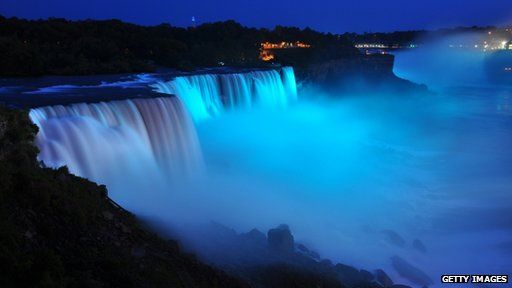Royal baby: America swoons for palace fairytale
- Published

Americans began July celebrating their independence from colonial rule. Less than three weeks later, many are rejoicing at the birth of a royal baby boy.
It is one of the great American paradoxes that a country which got rid of the monarchy in 1776 continues to lavish so much attention on the Royal Family.
One thing that the Windsors continue to command here is airtime on American television and column inches in the newspapers.
There has been blanket coverage on the rolling news channels. Websites such as the New York Post have redesigned their front pages to accommodate the breaking news.
News shows have also been heavily populated by plummy-voiced "royal watchers". For its rolling coverage, CNN bagged the British ambassador in Washington, Sir Peter Westmacott, who appeared resplendent in a red, white and blue tie.
'Stuffy protocols'
That news channel also replaced its normal jingles with regal-sounding music. Needless to say, the birth announcement has led all the network bulletins.
New Yorkers 'thrilled' by royal baby
Like CNN, ABC News replaced the thumping beat of its usual news anthem with dainty strings. One half-expected the news anchor, Diane Sawyer, to appear in period costume.
For weeks now, as the "great Kate wait" continued, the US media has covered the story from all manner of angles. The website The Daily Beast has focused on the possible stimulus effect of the birth on "austerity Britain."
National Public Radio was intrigued on what surname the new baby would have.
The New York Times, adopting a more sceptical tone, has tried to make sense of the "stuffy protocols" surrounding royal events, treating them as a throwback or museum piece.
For the New York Times, the royal easel erected on the forecourt of Buckingham Palace became an object of great fascination.
I was in Times Square in the heart of New York City when the news started coming through, which soon flashed up on the big screen news tickers.
Some people could hardly contain their delight. One woman screamed: "Oh my god. Oh, great, alright!"
Another said: "Oh congratulations, Kate, that's awesome."
Others could not really care less.
'Diana effect'
In a corner of Greenwich Village sometimes known as Little Britain, a restaurant catering for those with the taste for the United Kingdom hung up union flag bunting and "It's a Boy" celebratory banners. Champagne was sipped from bone-china teacups.
President Barack Obama and his wife, Michelle, were quick to send their congratulations to the royal couple on the occasion.
"We wish them all the happiness and blessings parenthood brings," they said.
"Given the special relationship between us, the American people are pleased to join with the people of the United Kingdom as they celebrate the birth of the young prince."
Of course, that special relationship, that connection between Britain and America, explains much of the wall-to-wall coverage.
And US historians will tell you that the fascination with the royals is nothing new. The coronation of Queen Victoria, for instance, was one of the great news events of its day.
What is new is the marriage of British regal tradition with American celebrity culture - a union which came to be crystallised in 1985 when Princess Diana danced with John Travolta at a White House state dinner.
Princess Diana became Vanity Fair magazine's favourite cover girl. Her death was as much an emotional event for many Americans as it was for grieving Britons.
Hollywood A-list
Tellingly, much of the coverage has focused on the absence of Diana. "What about the grandmother they will never meet?" asked ABC news anchor Diane Sawyer, wistfully.
To this day the two princes, William and Harry, remain beneficiaries of the "Diana effect".
When Harry toured America in May he was greeted with what the local media called "Harrymania".
The Duchess of Cambridge is also a hugely popular figure here, and has become a fashion icon.
They have become A-list celebrities in the US cultural hierarchy, with the star power to eclipse even Hollywood's biggest names.
As the American reaction to the royal birth reminds us, the royals have become an offshoot of the US entertainment industry.
This royal birth also serves as another reminder of America's umbilical link with Britain.